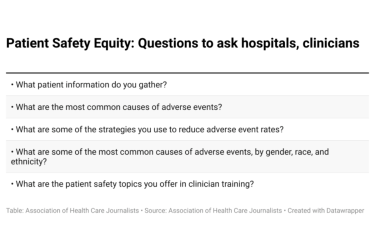
Efforts to improve health care quality and safety are mostly missing one significant source of concern: diagnostic errors, according to a report Tuesday from the Institute of Medicine. Improving Diagnosis in Health Care is the fourth in a series of IOM reports on patient safety.
In this Sept. 22 report, the IOM said that about 5 percent of U.S. adults who seek outpatient care experience a diagnostic error each year. Diagnostic errors contribute to about 10 percent of patient deaths, and account for about 6 percent to 17 percent of adverse events in hospitals.
“Diagnostic errors may cause harm to patients by preventing or delaying appropriate treatment, providing unnecessary or harmful treatment, or resulting in psychological or financial repercussions,” the report said.
Efforts to improve health care quality and safety have been inattentive to the problems built into the diagnosis process and the occurrence of diagnostic errors, according to the report, adding “Urgent change is warranted to address this challenge.”
The 21-member IOM committee writing the report defines diagnostic error as, “the failure to (a) establish an accurate and timely explanation of the patient’s health problem(s) or (b) communicate that explanation to the patient.”
It is significant that the definition and the report itself address the problem from the patient’s perspective, saying the “patient bears the ultimate risk of harm from diagnostic errors.”
In most health care settings, reaching a diagnosis is an “iterative and complex” process, the report says. As with its earlier reports on quality and patient safety, this IOM report identified failures in the U.S. health care system that have gone mostly unnoticed:
“Diagnostic errors stem from many causes, including inadequate collaboration and communication among clinicians, patients, and their families; a health care work system that is not well designed to support the diagnostic process; limited feedback to clinicians about diagnostic performance; and a culture that discourages transparency and disclosure of diagnostic errors, which in turn may impede attempts to learn from these events and improve diagnosis.”
The report makes eight recommendations (pdf), includes charts that explain the diagnostic process, and provides resources and a checklist for patients and family members.
Writing for Forbes, Arlene Weintraub explains in “Report: Doctors Are Screwing Up Diagnoses – And Patients Should Speak Out” (search site for title if article doesn’t display immediately) that communication among specialists is part of the problem as is a failure to communicate with patients and family members. Many pathologists work alone and rarely consult with treating physicians and other members of the care team. Although this culture is improving, change comes slowly.
Weintraub quoted a member of the IOM’s committee on diagnostic error, Michael B. Cohen, M.D., who is a professor of pathology and vice-chairman of the Department of Pathology at the University of Utah. “To improve the whole process we need to be better integrated in terms of how we address patients’ problems. Teamwork across disciplines is really critical,” Cohen told her.
Patients, providers, and health insurers got a wake-up call in 2000 when the IOM issued its first two reports on medical errors: To Err is Human: Building a Safer Health System in 2000, and a companion report in 2001, Crossing the Quality Chasm: A New Health System for the 21st Century. Those reports generated much discussion among health care professionals and this one may as well.









